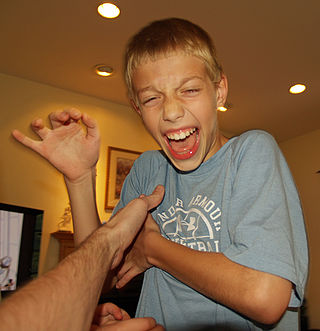Related Research Articles
Cross-cultural communication is a field of study investigating how people from differing cultural backgrounds communicate, in similar and different ways among themselves, and how they endeavor to communicate across cultures. Intercultural communication is a related field of study.
Symbolic communication is the exchange of messages that change a priori expectation of events. Examples of this are modern communication technology and the exchange of information amongst animals. By referring to objects and ideas not present at the time of communication, a world of possibility is opened. In humans, this process has been compounded to result in the current state of modernity. A symbol is anything one says or does to describe something, and that something can have an array of many meanings. Once the symbols are learned by a particular group, that symbol stays intact with the object. Symbolic communication includes gestures, body language and facial expressions, as well as vocal moans that can indicate what an individual wants without having to speak. Research argues that about 55% of all communication stems from nonverbal language. Symbolic communication ranges from sign language to braille to tactile communication skills.

Body language is a type of communication in which physical behaviors, as opposed to words, are used to express or convey information. Such behavior includes facial expressions, body posture, gestures, eye movement, touch and the use of space. The term body language is usually applied in regard to people but may also be applied to animals. The study of body language is also known as kinesics. Although body language is an important part of communication, most of it happens without conscious awareness.

A gesture is a form of non-verbal communication or non-vocal communication in which visible bodily actions communicate particular messages, either in place of, or in conjunction with, speech. Gestures include movement of the hands, face, or other parts of the body. Gestures differ from physical non-verbal communication that does not communicate specific messages, such as purely expressive displays, proxemics, or displays of joint attention. Gestures allow individuals to communicate a variety of feelings and thoughts, from contempt and hostility to approval and affection, often together with body language in addition to words when they speak. Gesticulation and speech work independently of each other, but join to provide emphasis and meaning.

A wink is a facial expression made by briefly closing one eye. A wink is an informal mode of non-verbal communication usually signaling shared hidden knowledge or intent. However, it is ambiguous by itself and highly dependent upon additional context, without which a wink could become misinterpreted or even nonsensical. For example, in some regions of the world, a wink may be considered rude or offensive. Depending on the relationship of the people involved, a wink could possibly constitute a sexual gesture.

Greeting is an act of communication in which human beings intentionally make their presence known to each other, to show attention to, and to suggest a type of relationship or social status between individuals or groups of people coming in contact with each other. Greetings are sometimes used just prior to a conversation or to greet in passing, such as on a sidewalk or trail. While greeting customs are highly culture- and situation-specific and may change within a culture depending on social status and relationship, they exist in all known human cultures. Greetings can be expressed both audibly and physically, and often involve a combination of the two. This topic excludes military and ceremonial salutes but includes rituals other than gestures. A greeting, or salutation, can also be expressed in written communications, such as letters and emails.

Nonverbal communication (NVC) is the transmission of messages or signals through a nonverbal platform such as eye contact, facial expressions, gestures, posture, use of objects, body language, social cues, kinesics, distance (proxemics), physical environments/appearance, voice (paralanguage), and touch (haptics). When communicating, we utilize nonverbal channels as means to convey different messages or signals, whereas others can interpret these message. The study of nonverbal communication started in 1872 with the publication of The Expression of the Emotions in Man and Animals by Charles Darwin. Darwin began to study nonverbal communication as he noticed the interactions between animals such as lions, tigers, dogs etc. and realized they also communicated by gestures and expressions. For the first time, nonverbal communication was studied and its relevance questioned. Today, scholars argue that nonverbal communication can convey more meaning than verbal communication.
Intercultural communication is a discipline that studies communication across different cultures and social groups, or how culture affects communication. It describes the wide range of communication processes and problems that naturally appear within an organization or social context made up of individuals from different religious, social, ethnic, and educational backgrounds. In this sense, it seeks to understand how people from different countries and cultures act, communicate, and perceive the world around them. Intercultural communication focuses on the recognition and respect of those with cultural differences. The goal is mutual adaptation between two or more distinct cultures which leads to biculturalism/multiculturalism rather than complete assimilation. It promotes the development of cultural sensitivity and allows for empathic understanding across different cultures.

Haptic communication is a branch of nonverbal communication that refers to the ways in which people and animals communicate and interact via the sense of touch. Touch is the most sophisticated and intimate of the five senses. Touch or haptics, from the ancient Greek word haptikos is extremely important for communication; it is vital for survival.

Namaste, sometimes called namaskar and namaskaram, is a customary Hindu manner of respectfully greeting and honouring a person or group, used at any time of day. It is used in the Indian subcontinent, and among the Indian and Nepalese diaspora. Namaste is usually spoken with a slight bow and hands pressed together, palms touching and fingers pointing upwards, thumbs close to the chest. This gesture is called añjali mudrā; the standing posture incorporating it is pranamasana.
Inter-cultural communication principles guide the process of exchanging meaningful and unambiguous information across cultural boundaries, that preserves mutual respect and minimises antagonism. Intercultural communication can be defined simply by the communication between people from two different cultures. In response to the fact that communication between cultures can be challenging, principles have been developed to accommodate respectful inter-cultural conversations. These principles are based upon normative rules, values and needs of individuals, understanding ethics within cultural communication and overcoming pre-existing cultural assumptions towards one another.
A nod of the head is a gesture in which the head is tilted in alternating up and down arcs along the sagittal plane. In many cultures, it is most commonly, but not universally, used to indicate agreement, acceptance, or acknowledgement.

A shrug is a gesture performed by raising both shoulders, and is a representation of an individual either being indifferent about something or not knowing an answer to a question.

The OK gesture or OK sign or ring gesture is performed by joining the thumb and index finger in a circle, and holding the other fingers straight or relaxed away from the palm. Commonly used by scuba divers, it signifies "I am OK" or "Are you OK?" when underwater. In most English-speaking countries it denotes approval, agreement, and that all is well or "okay". In other contexts or cultures, similar gestures may have different meanings including those that are negative, offensive, financial, numerical, devotional, political, or purely linguistic.

The sign of the horns is a hand gesture with a variety of meanings and uses in various cultures. It is formed by extending the index and little fingers while holding the middle and ring fingers down with the thumb.

In anthropology, high-context culture and low-context culture are ends of a continuum of how explicit the messages exchanged in a culture are and how important the context is in communication. The continuum pictures how people communicate with others through their range of communication abilities: utilizing gestures, relations, body language, verbal messages, or non-verbal messages. "High-" and "low-" context cultures typically refer to language groups, nationalities, or regional communities. However, the concept may also apply to corporations, professions, and other cultural groups, as well as to settings such as online and offline communication. High-context cultures often exhibit less-direct verbal and nonverbal communication, utilizing small communication gestures and reading more meaning into these less-direct messages. Low-context cultures do the opposite; direct verbal communication is needed to properly understand a message being communicated and relies heavily on explicit verbal skills. The model of high-context and low-context cultures offers a popular framework in intercultural-communication studies but has been criticized as lacking empirical validation.

A thumb signal, usually described as a thumbs-up or thumbs-down, is a common hand gesture achieved by a closed fist held with the thumb extended upward or downward, respectively. The thumbs-up gesture is associated with positivity, approval, achievement, satisfaction and solidarity, while the thumbs-down gesture is associated with concern, disapproval, dissatisfaction, rejection and failure.

A head shake is a gesture in which the head is turned left and right along the transverse plane repeatedly in quick succession. In many cultures, it is most commonly, but not universally, used to indicate disagreement, denial, or rejection. It can also signify disapproval or upset at a situation, often with slower movement. Head shaking while trying food, in Western cultures, can also communicate one is enjoying the food or a strong approval of it.

Waving is a nonverbal communication gesture that consists of the movement of the hand and/or entire arm that people commonly use to greet each other, but it can also be used to say goodbye, acknowledge another's presence, call for silence, or deny someone. The wave gesture is an essential element of human language.
References
- ↑ Kavita Pillay (30 January 2006), How to Tilt Your Head Like an Indian, World Hum, archived from the original on 3 March 2011, retrieved 27 March 2011
- ↑ Seth Stevenson (27 September 2004), "Actually Liking Stuff", Trying Really Hard To Like India, Slate, archived from the original on 1 February 2011, retrieved 27 March 2011
- 1 2 3 Sharell Cook (9 April 2020). "What is the Meaning of the Indian Head Wobble?". TripSavvy. Archived from the original on 25 December 2019. Retrieved 9 December 2019.
- ↑ Craig Storti (2007), "The Indian "Yes" Head Gesture", Speaking of India: Bridging the communication gap when working with Indians, Intercultural Press
- ↑ Chad Lewis (2008), Successful Communication in Multicultural Environments (PDF), Intercultural Focus, archived (PDF) from the original on 21 March 2012, retrieved 27 March 2011